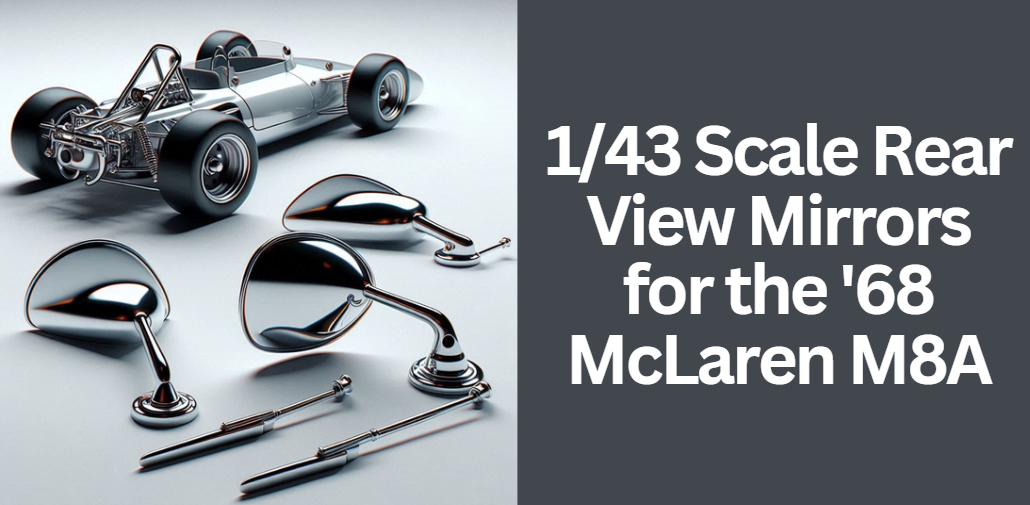The ’68 McLaren M8A remains an icon in the world of racing and automotive design. For collectors who value precision and authenticity, incorporating accurate scale accessories like rear view mirrors is essential.
In this guide, we explore why these mirrors are not just decorative but play a significant role in maintaining the model’s authenticity. Our goal is to provide you with a detailed, engaging, and easy-to-read resource that not only educates but also inspires collectors to achieve the perfect display.
Understanding Scale Models: The 1/43 Standard
What Does 1/43 Scale Mean?
In the realm of model building, a 1/43 scale means that every inch on the model represents 43 inches on the actual vehicle. This standard is popular among collectors due to its perfect balance between detail and manageability. Many collectors appreciate 1/43 scale models because they provide intricate details without being too cumbersome for display.
Benefits of the 1/43 Scale
Choosing a 1/43 scale model offers several advantages:
- Detail and Realism: Models built to this scale capture minute details, from intricate paintwork to the precise curves of the vehicle.
- Display Versatility: Their size makes them ideal for both small and large displays.
- Collectibility: High-quality scale models often appreciate in value and become prized collector’s items.
Enhancing Value with Authentic Accessories
Accurate accessories like rear view mirrors can enhance the overall value and authenticity of the model. For example, just as enthusiasts cherish the amt 1/16th scale schwinn bicycle orange for its attention to detail, similarly crafted rear view mirrors for the ’68 McLaren M8A are crucial for a complete and accurate display.
A Brief History of the ’68 McLaren M8A
The ’68 McLaren M8A is steeped in racing heritage. Emerging during a period of innovation, it combined cutting-edge design with performance that left a mark on the racing world. The McLaren M8A was renowned not only for its speed but also for its striking aesthetic, with rear view mirrors playing a subtle yet important role in the overall design.
Understanding the evolution of these features offers valuable context for modern collectors aiming to recreate the original look.
The Role of Rear View Mirrors in Automotive Design
Rear view mirrors are much more than functional components in full-scale vehicles. They contribute significantly to the design and aesthetics, both in real cars and in scale models. When these mirrors are accurately replicated in a 1/43 scale model, they add to the visual authenticity and historical accuracy.
The subtle curves, reflective surfaces, and precise alignment all work together to mimic the original design, creating a model that truly stands out.
Overview of 1/43 Scale Rear View Mirrors for the ’68 McLaren M8A
Modern replicas of rear view mirrors for the ’68 McLaren M8A strive for high precision and accuracy. Manufacturers employ a combination of die-cast metal and high-quality plastics to recreate every detail of the original mirrors. These accessories are designed to fit perfectly with the model, ensuring that collectors experience an immersive and authentic build.
Below is a table summarizing the key technical specifications of a typical 1/43 scale rear view mirror for the ’68 McLaren M8A:
| Specification | Detail |
|---|---|
| Scale | 1/43 |
| Material | Die-cast metal with plastic accents |
| Dimensions (approx.) | Varies with model, highly precise |
| Finish | Chrome-plated with hand-painted details |
| Compatibility | Designed specifically for the ’68 McLaren M8A |
Detailed Product Specifications and Technical Insights
In this section, we explore the technical aspects of these mirrors. Collectors demand precision, so manufacturers utilize advanced engineering techniques and high-quality materials to ensure that every curve, angle, and reflective surface is true to the original.
The mirrors are carefully measured to match the dimensions of the full-scale vehicle, ensuring a perfect fit when integrated with the model. Details such as the chrome finish, the use of die-cast parts combined with plastic, and the inclusion of subtle decals are all considered to guarantee authenticity.
How to Choose the Best 1/43 Scale Rear View Mirror
When selecting a rear view mirror for your model, it is important to consider several factors. First, assess the authenticity of the design. Does the mirror match the original specifications from the ’68 McLaren M8A? Second, evaluate the quality of the materials—premium die-cast metal and high-grade plastics should be used. Finally, check reviews and expert opinions, as these can provide insight into durability and overall satisfaction.
For those who also appreciate unique collectibles, exploring related products like the amt 1/16th scale schwinn bicycle orange might offer additional inspiration on quality and design standards.
Installation and Integration Guide
Proper installation is key to achieving a seamless display. Begin by ensuring you have the correct tools, such as precision screwdrivers, tweezers, and adhesive designed for model parts. Follow these steps to integrate your rear view mirror:
- Carefully align the mirror with the designated mounting area on your model.
- Secure it using the provided screws or adhesive, ensuring that it fits flush against the body.
- Adjust the angle of the mirror to replicate the original design.
- Review your work under good lighting to confirm the alignment and detail.
A simple diagram or illustration can help visualize these steps for even better clarity.
Maintenance and Preservation of Scale Mirrors
To maintain the quality and appearance of your 1/43 scale rear view mirrors, regular cleaning and proper storage are essential. Use a soft cloth and mild cleaning solution to gently wipe away dust and fingerprints.
It is advisable to store your model in a cool, dry place, and use display cases to prevent accidental damage. Consistent maintenance not only preserves the model’s aesthetic appeal but also ensures that the accessory retains its historical value.
Frequently Asked Questions
Is it possible to combine different scale accessories on one model without compromising overall accuracy?
While mixing accessories from different sources is sometimes tempting, it is crucial to ensure that all parts are designed to the same scale and maintain consistent detailing. Incompatibility in color, finish, or mounting standards may result in an unbalanced appearance. Thorough research and careful selection of components that have been verified for scale accuracy will help achieve a cohesive model.
How can I verify that the 1/43 scale rear view mirrors for the ’68 McLaren M8A are authentic replicas?
To ensure authenticity, collectors should check for manufacturer markings, inspect the quality of materials used (such as high-grade die-cast metal and accurately finished plastic components), and compare the dimensions and design details against verified technical drawings or OEM specifications from the original vehicle. Professional reviews and trusted collector forums can also provide useful confirmation.
What are some common installation challenges for these scale mirrors and how can they be overcome?
Installers may face issues such as misalignment or difficulties in securing the accessory without damaging delicate parts. Using precision tools, following detailed installation diagrams, and practicing on spare parts or mock-ups can significantly reduce these challenges. Additionally, consulting with experienced model builders or customer support from reputable sellers can provide valuable insights.
Which maintenance practices can help preserve the finish and integrity of the scale mirrors over time?
Routine cleaning with a microfiber cloth and a mild, non-abrasive cleaning solution is recommended to prevent buildup of dust and grime. It is important to avoid harsh chemicals that might damage the chrome finish or plastic details. Proper storage in a climate-controlled environment and the use of display cases or protective covers can also minimize exposure to environmental factors that may cause deterioration.
What factors should be considered when choosing between aftermarket and original equipment manufacturer (OEM) scale accessories?
When deciding between aftermarket and OEM options, collectors should evaluate factors such as material quality, level of detail, precision of fit, and price. OEM parts are often prized for their authenticity, but high-quality aftermarket alternatives can sometimes offer better durability or enhanced details. Reading comparative reviews and understanding the reputation of the supplier are key steps in making an informed choice.
Conclusion
This guide has provided an extensive look into the world of 1/43 scale rear view mirrors for the ’68 McLaren M8A, covering historical context, technical details, selection criteria, installation, and maintenance.
In summary, investing in accurate, well-crafted scale accessories not only elevates the display of your model but also preserves a piece of automotive history. Whether you are a seasoned collector or a beginner, this guide is designed to help you achieve a perfect, authentic build that stands out in the competitive world of scale modeling.
More Posts
The Ultimate Guide to PO BOX 371330 CA 91337: Everything You Need to Know
Ultimate Guide to the Sandwich on Telera Crossword Clue
Exploring All Quiet on the Western Front Huda TV: A Comprehensive Guide
Comprehensive Guide to Label the Photomicrograph Based on the Hints Provided
Complete Guide To The Ullman Devices HTC-2LT Letter Of Conformity Pdf


